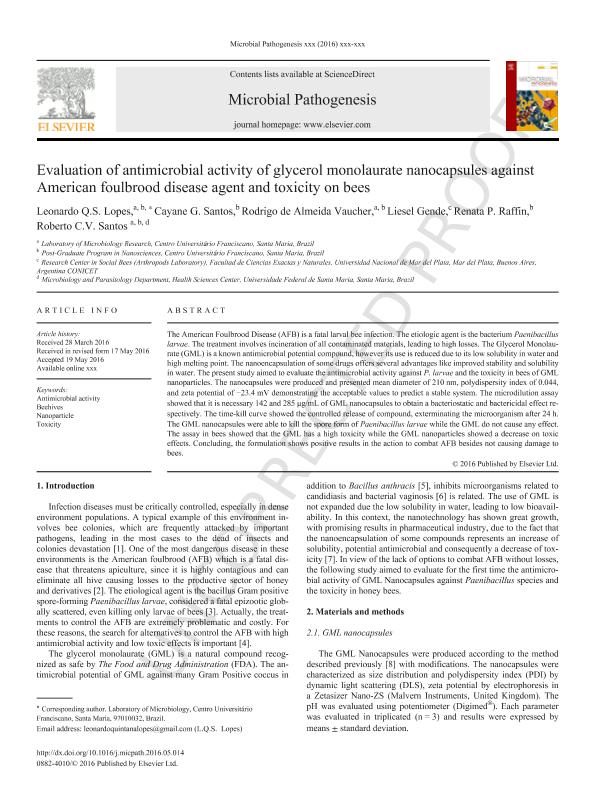Mostrar el registro sencillo del ítem
dc.contributor.author
Lopes, Leonardo Q.S.
dc.contributor.author
Santos, Cayane G.
dc.contributor.author
de Almeida Vaucher, Rodrigo
dc.contributor.author
Gende, Liesel Brenda

dc.contributor.author
Raffin, Renata P.
dc.contributor.author
Santos, Roberto C.V.
dc.date.available
2019-12-12T19:00:59Z
dc.date.issued
2016-08
dc.identifier.citation
Lopes, Leonardo Q.S.; Santos, Cayane G.; de Almeida Vaucher, Rodrigo; Gende, Liesel Brenda; Raffin, Renata P.; et al.; Evaluation of antimicrobial activity of glycerol monolaurate nanocapsules against American foulbrood disease agent and toxicity on bees; Academic Press Ltd - Elsevier Science Ltd; Microbial Pathogenesis; 97; 8-2016; 183-188
dc.identifier.issn
0882-4010
dc.identifier.uri
http://hdl.handle.net/11336/92091
dc.description.abstract
The American Foulbrood Disease (AFB) is a fatal larval bee infection. The etiologic agent is the bacterium Paenibacillus larvae. The treatment involves incineration of all contaminated materials, leading to high losses. The Glycerol Monolaurate (GML) is a known antimicrobial potential compound, however its use is reduced due to its low solubility in water and high melting point. The nanoencapsulation of some drugs offers several advantages like improved stability and solubility in water. The present study aimed to evaluate the antimicrobial activity against P. larvae and the toxicity in bees of GML nanoparticles. The nanocapsules were produced and presented mean diameter of 210 nm, polydispersity index of 0.044, and zeta potential of −23.4 mV demonstrating the acceptable values to predict a stable system. The microdilution assay showed that it is necessary 142 and 285 μg/mL of GML nanocapsules to obtain a bacteriostatic and bactericidal effect respectively. The time-kill curve showed the controlled release of compound, exterminating the microorganism after 24 h. The GML nanocapsules were able to kill the spore form of Paenibacillus larvae while the GML do not cause any effect. The assay in bees showed that the GML has a high toxicity while the GML nanoparticles showed a decrease on toxic effects. Concluding, the formulation shows positive results in the action to combat AFB besides not causing damage to bees.
dc.format
application/pdf
dc.language.iso
eng
dc.publisher
Academic Press Ltd - Elsevier Science Ltd

dc.rights
info:eu-repo/semantics/openAccess
dc.rights.uri
https://creativecommons.org/licenses/by-nc-sa/2.5/ar/
dc.subject
ANTIMICROBIAL ACTIVITY
dc.subject
BEEHIVES
dc.subject
NANOPARTICLE
dc.subject
TOXICITY
dc.subject.classification
Otras Ciencias Biológicas

dc.subject.classification
Ciencias Biológicas

dc.subject.classification
CIENCIAS NATURALES Y EXACTAS

dc.title
Evaluation of antimicrobial activity of glycerol monolaurate nanocapsules against American foulbrood disease agent and toxicity on bees
dc.type
info:eu-repo/semantics/article
dc.type
info:ar-repo/semantics/artículo
dc.type
info:eu-repo/semantics/publishedVersion
dc.date.updated
2019-12-05T18:06:13Z
dc.journal.volume
97
dc.journal.pagination
183-188
dc.journal.pais
Países Bajos

dc.journal.ciudad
Amsterdam
dc.description.fil
Fil: Lopes, Leonardo Q.S.. Centro Universitario Franciscano; Brasil
dc.description.fil
Fil: Santos, Cayane G.. Centro Universitario Franciscano; Brasil
dc.description.fil
Fil: de Almeida Vaucher, Rodrigo. Centro Universitario Franciscano; Brasil
dc.description.fil
Fil: Gende, Liesel Brenda. Consejo Nacional de Investigaciones Científicas y Técnicas; Argentina. Universidad Nacional de Mar del Plata. Facultad de Ciencias Exactas y Naturales; Argentina
dc.description.fil
Fil: Raffin, Renata P.. Centro Universitario Franciscano; Brasil
dc.description.fil
Fil: Santos, Roberto C.V.. Universidad Federal de Santa María; Brasil. Centro Universitario Franciscano; Brasil
dc.journal.title
Microbial Pathogenesis

dc.relation.alternativeid
info:eu-repo/semantics/altIdentifier/url/https://www.sciencedirect.com/science/article/pii/S0882401016301516
dc.relation.alternativeid
info:eu-repo/semantics/altIdentifier/doi/http://dx.doi.org/10.1016/j.micpath.2016.05.014
Archivos asociados
